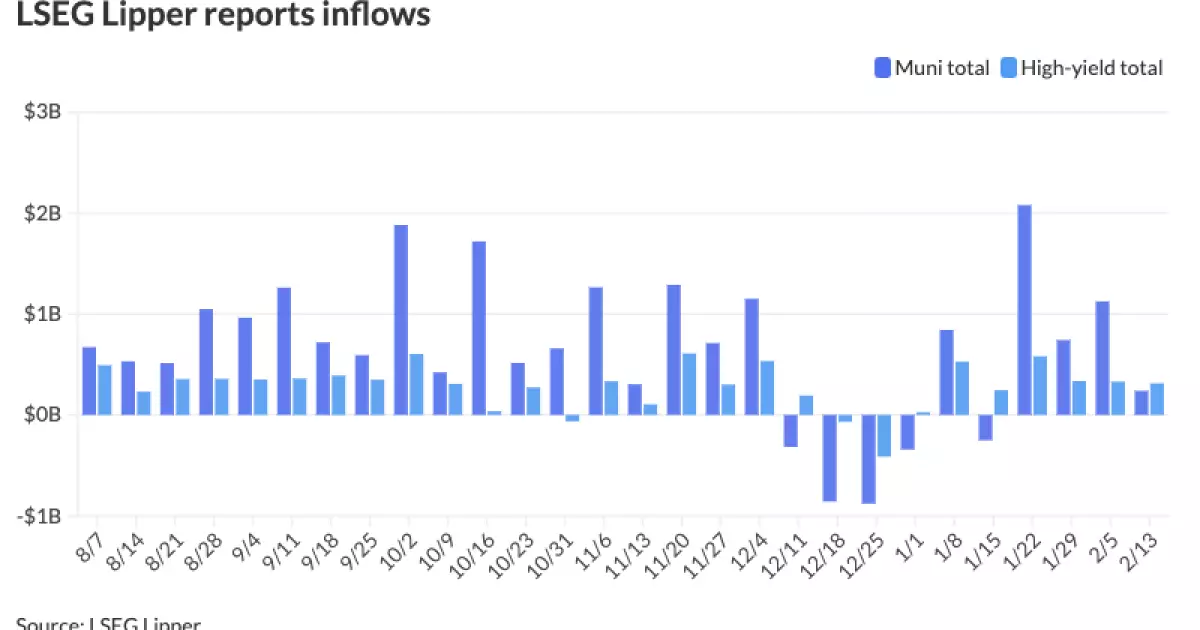The landscape of municipal bonds has notably shifted in recent weeks, marked by a firming of prices and improved confidence in the market as U.S. Treasury yields experienced a rally. The bond market displayed resilience, particularly in the face of potential shifts in economic and fiscal policies shaped by the government. A closer examination reveals the nuances influencing municipal bonds, traditionally seen as a safe harbor for investors, especially during uncertain economic times.
As of recent evaluations, the ratios of municipal bonds to U.S. Treasuries (UST) for different maturities have been stable: 63% for two-year bonds, 64% for five-year bonds, 67% for ten-year bonds, and 86% for thirty-year bonds. Such figures indicate a healthy demand and a competitive positioning of municipal bonds relative to their Treasury counterparts, providing a favorable backdrop for investors looking to mitigate risks associated with higher-yielding equities.
James Welch, a municipal portfolio manager at Principal Asset Management, pointed out that the future of municipal bonds is heavily influenced by government policies, particularly tax reforms initiated during the Trump administration. Tax changes can either bolster or challenge the municipal market, given that tax-exempt status is a core feature of these investments. The municipal bond market’s stability through recent turbulent times is a testament to its structural integrity, as it has effectively absorbed challenges posed by tariff announcements and government budget reconciliations.
Moreover, although the municipal bonds have lagged behind other asset classes in performance, their attractiveness remains evident as evidenced by a consistent flow of funds into municipal mutual funds. Recent LSEG Lipper data indicates that there has been a robust inflow, with $238.5 million added in the latest week alone, demonstrating a keen interest from investors despite fluctuating market dynamics.
High-Yield Demand and Market Dynamics
Importantly, the current inflows are not solely concentrated in traditional municipal securities but have also seen a significant chunk directed towards high-yield municipal funds. These funds saw inflows totaling $313 million in a recent week, reflecting investors’ appetite for riskier, higher-return possibilities within the municipal market. Welch predicted that this trend would persist, driven by heightened retail investor demand across various channels, including mutual funds and exchange-traded funds.
One critical factor propelling this demand is the ongoing infrastructure projects facing many municipalities, which frequently require financing through municipal bonds. Welch noted that issuers, now reliant on their own resources rather than pandemic-era funding, are in a position where they must pursue bond issuance to maintenance projects that can no longer be postponed.
The behavior of interest rates is another pivotal factor influencing the municipal bond market. The recent uptick in the seven-day SIMFA rate, which spiked due to increased demand for money market products, suggests that investors are actively maneuvering within cash products, seeking the best possible returns during a fluctuating economic landscape. This activity is indicative of how the broader economic environment can shift investor behavior, prompting a reassessment of treasury versus municipal holdings.
Additionally, adjustments in the municipal bond yield scales reveal a tightening across various maturities. With the MMD scale reflecting adjustments ranging from two to four basis points across the board, it underscores the demand stability and price resilience currently characterizing the market.
Trends in Municipal Issuances
In terms of new issuances, several notable transactions have unfolded. For instance, Morgan Stanley recently priced $1.209 billion in gas supply revenue refunding bonds for the Kentucky Public Energy Authority, signifying that major issuers are capitalizing on favorable market conditions to address financial needs. Similarly, Hawaii’s airports system revenue bonds’ significant tranches, including amounts near $854 million, reflect an active primary market filled with opportunities for investors.
Meanwhile, the rise of electronic trading and the growth of Separately Managed Accounts (SMAs) indicate a technologically driven evolution in the municipal bond landscape. As SMAs grow to represent an increasingly large portion of municipal bond trading, driven by automation and electronic trading’s efficiency, the market is anticipated to continue its robust participation well into the foreseeable future.
Despite external pressures and market fluctuations, municipal bonds exhibit a mix of resilience and adaptability. With increasing demand from retail investors, strategic inflows into high-yield funds, and active management of upcoming issuances, the municipal bond market remains a compelling choice for conservative investors aiming for stability and yield. As the economic climate continues to evolve, the proactive approaches adopted by market participants serve to reinforce the municipal bond sector’s foundational stability in an ever-changing financial landscape.


Leave a Reply